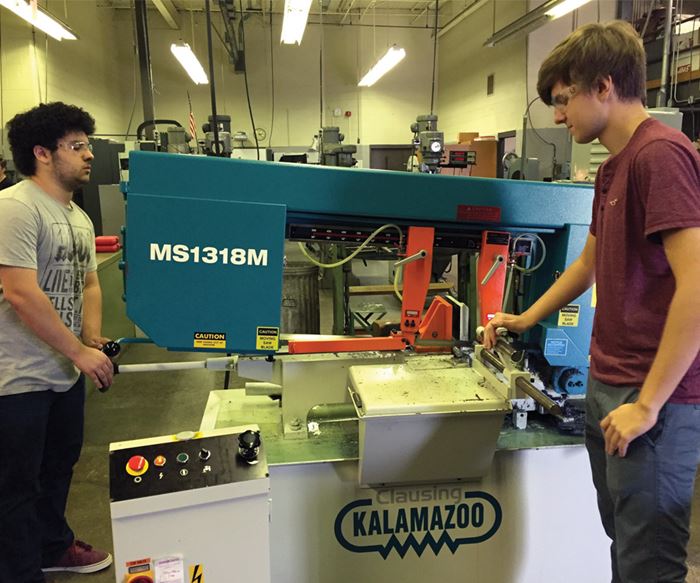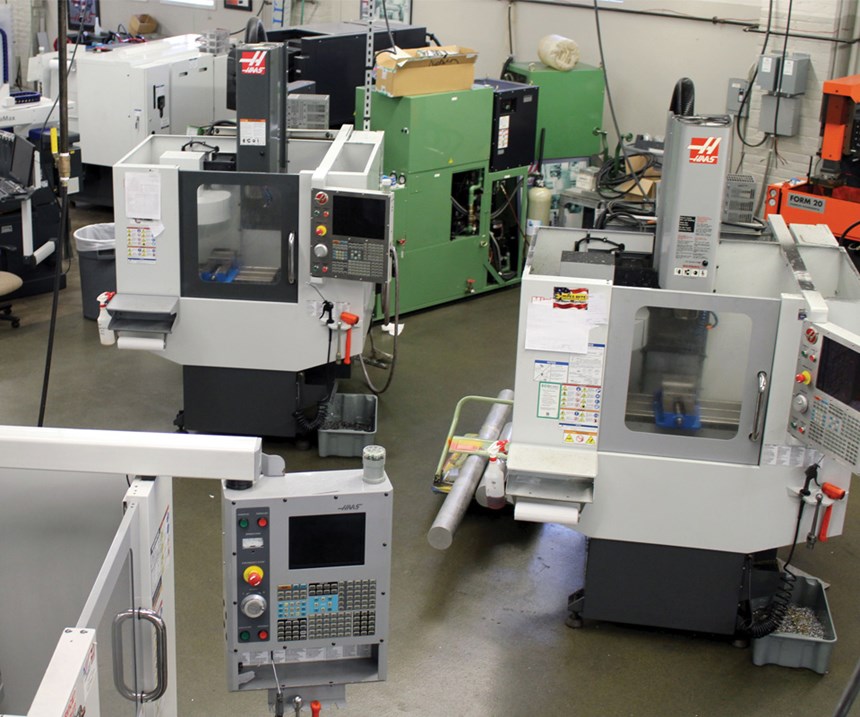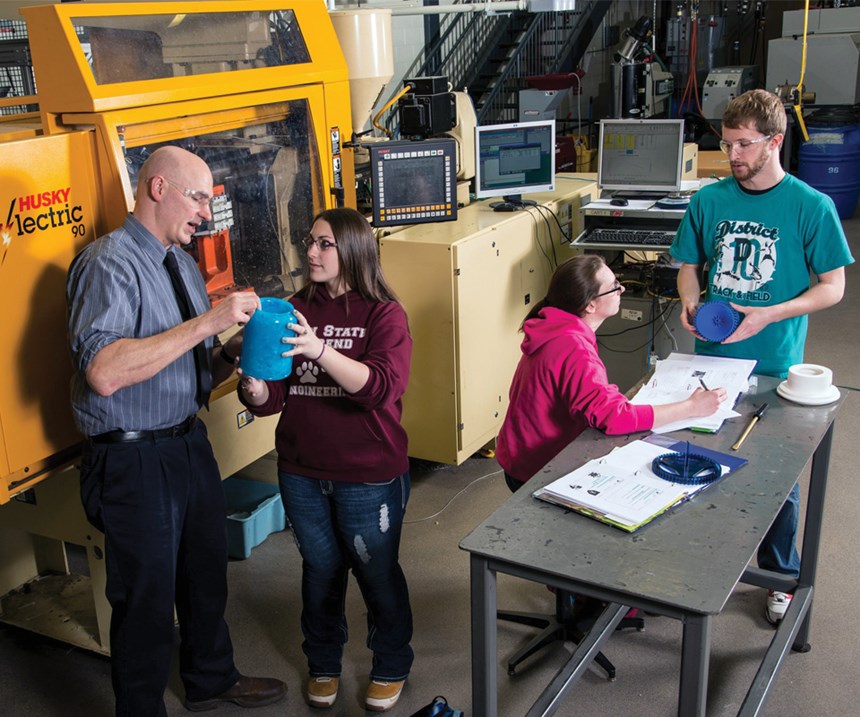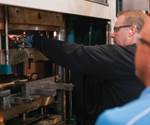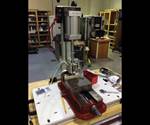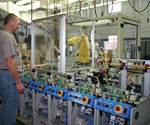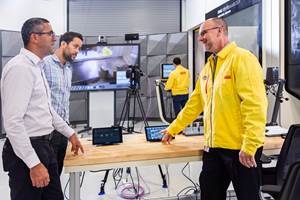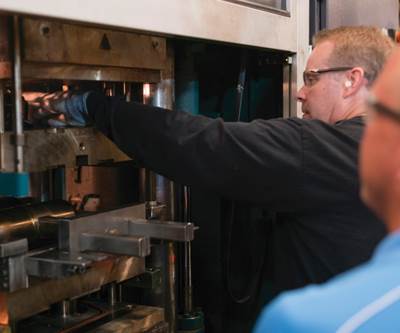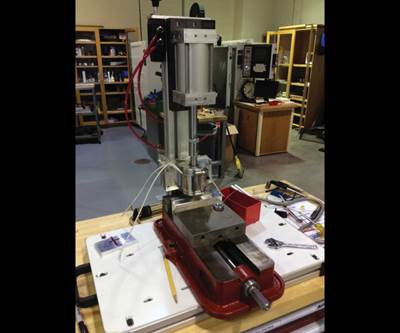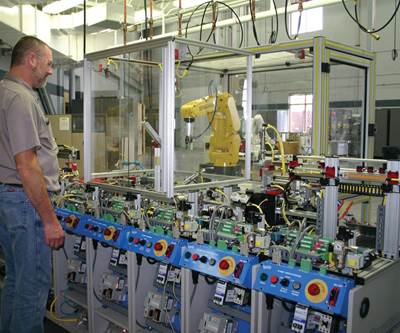Getting Real about Manufacturing Education
Some education programs are using real-world projects and engaging industry to better equip students with viable skills for careers in advanced manufacturing.
Learn how the Rockford Public Schools created a new high school education model by aligning education with industry to better prepare students for employment and/or higher education.
This article is part of a series highlighting ways in which schools, businesses and trade organizations are working together to shape the next generation of manufacturing professionals.
There seems to be a resurgence of interest in manufacturing as a career, helped along by businesses large and small that are making connections with educators and students in multifaceted ways. Some are partnering with local high schools and colleges to develop curricula relevant to the industry. Some are leading classes about subjects such as mechanical engineering or product design. Some are collaborating with students to study topics like the effects of part design on rheology.
In this first installment, we’re highlighting programs at three educational institutions: the Rockford Public Schools system in Rockford, Illinois; the Dunwoody College of Technology in Minneapolis, Minnesota; and the School of Engineering at Penn State Erie, the Behrend College in Erie, Pennsylvania. These programs were chosen from among many across North America that are helping fill the need for manufacturing career preparation by offering unique programs that do more than just preach—they challenge students with real-world situations to help them become more valuable employees.
High School Academies Offer Pathways to Careers
Engineering, Manufacturing, Industrial and Trades Technology (EMITT) is one of five career academies, or “small learning communities,” created by the Rockford Public Schools system to provide high school students with real-world learning experiences in partnership with local businesses and professionals. What’s unique about this educational model, according to Charles Kluzak, a teacher and business liaison for the EMITT academy at Jefferson High School, is that it provides “pathways” to hundreds of different careers so that students are better prepared for employment and/or higher education based on their individual interests. Each academy is divided into several such pathways, and each pathway exposes students to a number of potential careers. For example, EMITT’s pathways include architecture and construction, engineering, manufacturing operations, skilled trades and transportation technology. Potential careers under the manufacturing operations pathway might include assembler, design engineer, machinist, tool and die maker, or CNC programmer.
The idea for this five-academy system began with the creation in 2009 of Alignment Rockford, a group of business, civic, social, religious, educational and grassroots organizations that partnered with the school district to come up with best practices that would “increase student aspirations and achievement,” Kluzak says. “One goal is business integration and engagement in the schools, including providing students with job-shadowing opportunities, interviewing experience and more.”
Classes frequently are led by professionals from various businesses in the Rockford area who volunteer their time. Other professionals also might be invited to be guest speakers, perform in-class evaluations of student projects, mentor or tutor students, conduct mock job interviews, or host site visits for teachers and students.
Kluzak explains that the EMITT manufacturing operations program is project-based. Although learning takes place in a classroom, students are responsible for time cards, due dates and hot jobs. Basically, they are treated more like employees than students, he says.
Last year, students were given the opportunity to design and make 30 floor-plate outlet covers for the school district’s new administration building. Each unit was comprised of four pieces of steel, including a detachable cover. The students created a prototype in less than a day, he says, and presented a plan for how they would successfully complete the job in less than a week. They were awarded the contract and produced 35 units in six days using a TIG welder, Bridgeport mills, hand grinders and other tools. Some of the students worked before school, during lunches, after school and on Saturday to complete that job, he says.
“In addition to project-based learning, 50 percent of what we teach here are the soft skills like adaptability and responsibility, communications, problem-solving, and collaboration that many young students will never learn in high school,” Kluzak says. “They understand how valuable those soft skills are when they job shadow and visit sites. They quickly learn what real manufacturing companies expect from employees.”
In addition to EMITT, the other college and career pathway programs in the Rockford Public Schools system include Business, Arts, Modern World Languages and Information Technology; Health Sciences; Human and Public Services; Creative and Performing Arts; and the Gifted Academy. Each is designed to expose students to career path options and corresponding coursework. There is also a Freshman Academy, designed to support students transitioning from eighth grade to high school.
The school district offers several programs designed to guide eighth and ninth grade students toward careers that might suit their individual interests. They then can enter one of the six college and career academies in their sophomore year. The district also hosts an annual career expo for freshmen to help them choose an academy and career path. Exhibitor companies provide mostly interactive exhibits and activities designed to give students a taste of what working in various careers might be like, Kluzak says. The students also learn what educational requirements must be met to successfully find employment in these careers. “Granted, this two-and-a-half-hour expo won’t make the freshmen definitive on a career path, but they can get excited about something to start with,” he says.
College Program Promotes Collaborative Learning
For more than 100 years, Dunwoody College of Technology has been teaching toolmaking as part of its machine tool technology program, and, according to Dean of Manufacturing E.J. Daigle, moldmaking has been a part of the program since 1955, when the school acquired its first injection molding press. He says there are several aspects that set this program apart from others: an emphasis on real-world experience prior to graduation, close ties to industry-leading companies and collaborative learning opportunities with the college’s mechanical engineering program.
Students have access to and learn on a 55-ton injection molding press, 17 CNC machines and more than 40 manual machine tools, wire and sinker EDMs, shear/compression/tensile testers, coordinate measuring machines, CAD/CAM software, and 3D printers.
“In a region steeped in medical device manufacturing, there has always been a high demand for students trained in the art of moldmaking, metal stamping and casting, and our industry partners aren’t just hiring our graduates, they are informing our curriculum in new and innovative ways,” Daigle says.]
Partners such as Haas, Mastercam, MTS Systems, Solidworks, Stratasys and Zeiss have given students the opportunity to beta-test new, cutting-edge equipment, including some that has yet to be released to the market. For example, “students have beta-tested a prototype Haas CNC machine and innovative 3D-printed end-of-arm tools for industrial robots,” he says. “This means that our graduates not only have the skills they need to go to work on day one, but they are also prepared to use equipment that will be introduced in the near term.”
Dunwoody’s Program Advisory Committee includes leaders from a variety of different manufacturing companies who volunteer their time to ensure that the Dunwoody program and curriculum continues to train the future workforce in skills the industry needs. It is also one way Dunwoody works to foster close ties between industry and its students.
Dunwoody also holds weekly events called Focus Fridays, in which area companies are invited to set up a table in the machine tool shop with the purpose of meeting Dunwoody students, sharing information about career options and new technologies, and hiring them to work part-time during the school year. “The demand (for space at Focus Fridays) far outweighs the availability,” Daigle says. “Within two weeks of sending out the invite, all 30 available Fridays were taken.”
Students in the Dunwoody machine tool program also have a unique opportunity to learn beyond what’s taught in their program through collaboration with the college’s four-year mechanical engineering program. “Many universities have an engineering program, and many technical colleges have a tool and die program, but very few have both,” Daigle says.
Every machine tool student designs and builds a plastic injection mold of his or her own using quick-change mold inserts and master unit dies. The students use sinker EDMs to make graphite electrodes and the array of CNC machining centers to manufacture the molds. This is the type of real-world experience employers are looking for, Daigle says. Students are then required to run 100 parts on their molds, and samples are inspected using the equipment in the college’s metrology lab. Collaborative projects have included the design and build of a mold to produce polymer tensile test samples for the mechanical engineering program. This mold was used to run parts in high-density polyethylene, glass-filled polystyrene and polypropylene so that the students could learn about and analyze the various polymer materials and blends.
According to Daigle, the result of all the real-world experience gained through the college’s program gives its students an advantage in securing paid employment. “In fact, by the time a class has finished its first year in the program, most students have already been placed in the field. Each year, the machine tool technology program has an average of 300 requests to hire 30 students,” he says.
University Program Connects Academia with Industry
The plastics engineering technology (PLET) program at Penn State Behrend ranks as one of only four programs in the U.S. that are accredited by the Accreditation Board for Engineering and Technology (ABET) and boasts the largest plastics lab dedicated to undergraduate learning. Its 10,300-square-foot molding facility features 14 injection molding machines and gives students hands-on experience in the integration of new technologies in design, materials, tooling and processing, says Jason Williams, senior lecturer in the School of Engineering.
Williams, himself a graduate of the PLET program, says stressing the link between processing, materials, design and tooling is integral to successfully training the next generation of mold manufacturing professionals. “All four of these form the ‘legs of the stool’ that support engineering and plastics technology,” he says. “We try to teach students the importance of each of these topics by consistently addressing them throughout the curriculum. We force students to think analytically about the bigger picture. I like to use the analysis of parting lines and drafts in my classes to help drive these disciplines home, for instance. By the third year, we start to see them thinking about these ‘legs’ more innately.”
About 85 percent of the engineering school faculty members have related work experience outside the classroom, while 100 percent of the plastics program faculty have worked specifically in the plastics industry, Williams says. This is a great advantage, because their experiences drive them to continually challenge students to look for solutions beyond what’s written in a textbook, he says.
Williams says that, at the suggestion of an industrial advisory board, the engineering department has recently added a course in failure analysis that looks at real and simulated examples of product failures and challenges students to draw from what they’ve learned in their courses on materials, design, processing and tooling to determine causes for failures in plastic components. The students then must propose appropriate solutions to those problems.
One project evaluated a writing stylus for a computer tablet. “The tip was smashed, so we did a hoop stress failure on the tip of the pen,” explains the course’s instructor, Alicyn Rhoades, Ph.D., assistant professor of engineering. “First, we used new thermal analysis techniques to identify the material. We then sectioned the pen so the students could understand how the assembly was put together, and they modeled it using Ansys software and recreated the plastic filling simulation. The question was posed: Was this user failure, or was the pen not designed properly?”
Rhoades says the other objective of the failure analysis class is to expose students to techniques that are outside of the typical toolbox. For instance, students have studied mass spectrometry to identify the degradation process of polycarbonate.
Senior capstone projects are part of Penn State Behrend’s Open Lab, a college-wide outreach initiative that combines applied research and collaboration with industry. “We wanted to strengthen the link between industry, and our faculty and undergrads to get away from that ‘black box’ type of research where we conduct it but companies aren’t involved,” Williams says. “Together, we can do more.” He says approximately 70 percent of senior design projects are sponsored by industry partners that range from local inventors needing product development assistance to regional tooling and molding companies looking to conduct research on a new processing method.
The Open Lab program occupies industrial space adjacent to campus called “Knowledge Park.” There, companies can establish offices staffed with several of their engineers and Penn State students who work for them part time, Williams says. For example, the 1,400-square-foot SKF North America Aerospace Innovation Center has more than a dozen students and engineering faculty members collaborating on long-term projects with SKF teams in the United States and Europe. The school last year also opened the Advanced Manufacturing and Innovation Center (AMIC), a 60,000-square-foot building occupied by five classrooms, 27 faculty offices and laboratories for both mechanical engineering and industrial engineering programs. The building’s east wing, which includes 19,000 square feet of manufacturing space, is available for companies to lease for further Open Lab initiatives, Williams says.
In addition to capstone projects, students also can participate in other industry-sponsored, undergraduate research with faculty members. Williams, for example, says he hired two students to work with him over the past two years on a proprietary project to investigate and test new mold construction methods with the goal of reducing cycle times. “We found some approaches we wanted to look at, and the students were responsible for most of the processing measurement, molding trials and other procedures,” he says.
These and other educational programs are designed not only to help students connect with industry, but also to help them explore pathways to careers in advanced manufacturing. We will continue to highlight other programs in future articles.
Related Content
How to Foster Innovation Through a Culture of Education, Mentoring
Dynamic Tool Corp. shares its strategy for building a team with the right attitude and aptitude to deliver innovation that meets customer expectations.
Read MoreThe Role of Social Media in Manufacturing
Charles Daniels CFO of Wepco Plastics shares insights on the role of social media in manufacturing, how to improve the “business” side of a small mold shop and continually developing culture.
Read MoreHow to Use Continuing Education to Remain Competitive in Moldmaking
Continued training helps moldmakers make tooling decisions and properly use the latest cutting tool to efficiently machine high-quality molds.
Read MoreMaking Quick and Easy Kaizen Work for Your Shop
Within each person is unlimited creative potential to improve shop operations.
Read MoreRead Next
Breaking Down the Skills Gap, Part 1
You can’t solve a problem without defining it first. This two-part series will help define the skills gap and offer solutions for closing it.
Read MoreProject-Based Learning
University education in a shop-like setting helps mold a new generation of enterprising engineers.
Read MoreBreaking Down the Skills Gap, Part 2
With the skills gap now defined, the next step is implementing strategies to close it.
Read More
